
Für eine deutsche Übersetzung dieser Seite einfach die Brandenburger Flagge anklicken
 |
Click the Brandenburg Flag for a German translation
Für eine deutsche Übersetzung dieser Seite einfach die Brandenburger Flagge anklicken |



|
Home TownsHistory of Potsdam, Germany |
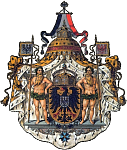
|



 |
This site is part of our Potsdam, Germany site. Click the left turn sign to get back to the Potsdam Start Site. |


|
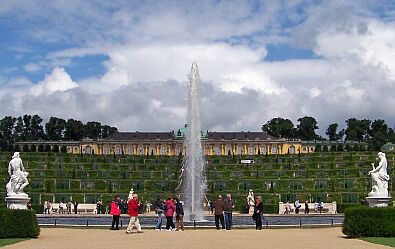
|

|
Potsdam is to
Germany what Versailles is to France or Windsor to England.
People have been living in this area for the last 5,000 years and the town
itself dates back to the year 993, then a Slavonic village in a country that was just to become Germany.
For a thousand years, many of the best and
some of the worst moments of German history happened
here. Here is a very brief history of the town |

|


2,200 BC Soon after the ice was gone, prehistoric people moved into the area. There is evidence of a permanent settlement dating back to the Early Bronze Age. In 2007, a grave, dating back to the Stone Age was discovered right downtown. The grave site contained an about 20 year old male who was buried with eight arrowheads and a clay jar containing food for the journey to wherever he believed he was going to.  The find was a sensation and the skeleton, named "Pötzi" was soon put on display in a museum. You can see a picture here and a short report in German language here, but please read below what we think about this kind of display: |
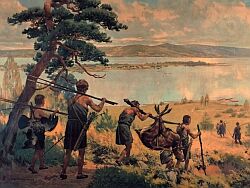
|
| If someone would dig up our grand parents and put them on display, we would call it a sacrilege. We believe there is no statute of limitation to this kind of vandalism. Pötzi's family had a spiritual reason to bury him at this place and in this manor. We understand that science can learn a lot from finds like this, but the public display - as profitable as it might be - is very disrespectful to those who were here before us. We hope that, after historians found out all they could, Pötzi will be put back to rest. We think a respectful grave site could be more educational than a distasteful display of human bones. |

50 BC - 150 AD
 The Bronce Age people were the ancestors of the first Germanic people, the Suebi. Written history first mentions the Suebi in 59 BC in connection with a battle between Germanic tribes led by Ariovistos and the 10th Legion of the Roman Empire under Julius Caesar.  While "Suebi" was a general term for all the Germanic tribes between the Baltic Sea and rivers Elbe and Oder, the Germanic nation settling along River Havel was called the Semnoni. 1st Century AD Roman historian Tacitus described them as the "head of the Suevic race." |
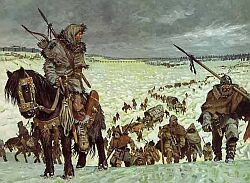
|

150 - 407 AD
 The migration of the Goths from the Baltic Sea to the Black Sea and later the invasion of the Huns, coming from Central Asia, turned the European map upside down and triggered the great European Migration Period. In their quest for new and better lands, several nations crossed the territory of the Germanic tribes and around the year 200, the Semnoni joined the migration and moved south. Later, in the year 407, several Germanic tribes conquered parts of Gaul, causing even the last Germanic people along River Havel to leave for greener pastures. |
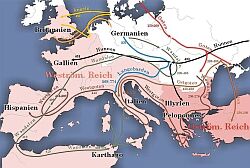
|

562
 While the Germans and other nations moved back west, the now empty land in Central Europe was flooded with nomadic pastoral people coming all the way from the steppes of Eastern Europe and Asia. History often generalizes them as "The Huns", but there were a lot more of them than just Attila's horsemen.  In the 500s, the Avars, a nation of Central Asian nomad warriors extended their territory from the Caspian Sea all the way to the Baltic. In 562, they reached River Havel. However, they left again around 590, concentrating their forces on the battle with the Byzantine Empire. |

|

600
 Ever since the Bronce Age, Rivers Havel and Spree formed the somewhat blurred borderline between a Proto-Germanic and a Proto-Slavic culture. So, not surpringly, after the Germans had moved south and west and the Avars went back to where the once came from, Slavonic people settled in the area. They named themselves after the Rivers along wich they lived. The Hevelli derived their name from River Havel, while the Sprewani were named after River Spree. Germans would later call all the Slavonic nations in the area Wends. 
XXXXXXXXXXXXXXXXXXXXXXXXXXXXXXXXX Replica of a Hevelli fortress |
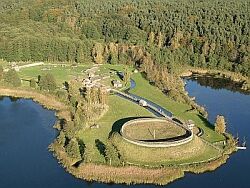
|
 The Hevelli settled in the area that is now Potsdam and built a permanent stronghold at a passage across river Havel. The Latin name of the fortess - Poztupimi - is most likely derived from the Slavonic words "pod" (under) and "dubimi" (oaks). The Hevelli ruled the area for over 300 years. |

928
 In 928, Henry the Fowler conquered the fortress. He was the first Germanic King to extend German rule east of River Elbe. In 948, his son, Otto I founded the first Christian diocese in what was later to become Brandenburg.
983
XXXXXXXXXXXXXXXXXXXXXXXXXXXXXXXXX Replica of a Slavonic statue |
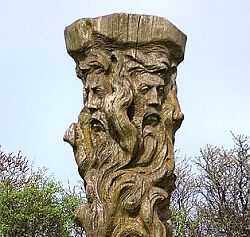
|

|
July 3, 993 This deed of endowment is the oldest physical evidence of the name Poztupimi. In July 993, German Emperor Otto III gave the then tiny hamlet Poztupimi as a gift to the Quedlinburg Abbey. Technically, Otto gave away something that didn't belong to him in the first place. Slavonic tribes constantly challenged German
authority east of the Elbe and Otto's deed was not more than an attempt to stem back their influence.
|

|

1147
 In the early 12th century, German archbishops and Kings sought the conversion of neighboring "pagan" Wends, to Christianity through peaceful means. But for the Wends, Christianity usually meant servitude and foreign occupation, and thus, the peaceful conversion only had limited success.  Encouraged by the outcome of the First Crusade Pope Eugene III issued a papal bull calling for a crusade the non-Christian nations between Rivers Elbe and Oder. He compared the undertaking with the Second Oriental Crusade. Eventually, activities culminated in the Wendish Crusade of 1147.  XXXXXXXXXXX German Bishop Absalon toppling a statue of the Wendish God Svantevit |
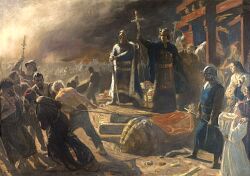
|

Compared to the brutality used in the Crusade, its results were paltry. However, the German side managed to restore the
Havelberg and
Brandenburg bishoprics.
 One of the German commanders of the Crusade was an Ascanian prince called Albert the Bear. But Albert's biggest victory was not won on the battlefield but through diplomacy and perhaps even friendship across borders and religious boundaries. He built close relations with the Wendish leader of the Brandenburg region, a Hevelli prince called Pribislav. |


1157
 After crushing the last Wendish resistance in 1157, Albert took the title "Margrave of Brandenburg." Ever since, June 11, 1157, has been celebrated as the birthday of the Brandenburg Margraviate. Albert encouraged German migration and established new dioceses under his protection. He also became Arch-Chamberlain of the German Empire, which gave the Margraves of Brandenburg electing power when it came to the election of German Emperors. The Ascanians ruled for 170 years. In the second half of the 12th century, they decided to fortify their border along rivers Havel and Nuthe and to build a number of fortresses. |

1220 & 1317
 In Potsdam, near what is now Lange Brücke, a fortification was built around 1160. By 1220 the Ascanians had turned this stronghold into a fort with stockade and tower. A document dating back to 1317 mentions the fortress. The paper also makes note of a cobblestone-made Church of St. Mary at the location of today's Church of St. Nicholas. It was the first time, that Potsdam was called a civitas (meaning town). The name used for modern castle was Postamp. In Slavonic languages, Postamp meant Home of the Postapim, which most likely meant the inhabitants of historic Poztupimi.  XXXXXXXXXXXXXXXXXXXXXXXXXXXXXXXX Fort at River Havel around 1220 |
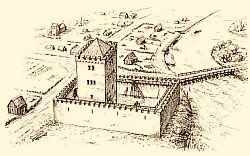
|
 If one wants to be overly accurate, one might notice, that the center of the settlement had shifted half a mile westwards from the old Hevelli fortress at the confluence of rivers Havel and Nuthe to the modern Ascanian castle. While the name Postamp was used for the new castle and the surrounding settlement, the old fortress would still be called Poztupimi for a while. 
Power Vacuum
|


1348
 1348 must have been one of the worst years for Potsdam and the Brandenburg Margraviate. The Bavarians mismanaged the land so badly that for a number of years an impostor got hold of the Brandenburg throne just by claiming he was the last Ascanian prince. Rivalry between the Houses of Wittelsbach and Luxembourg almost caused a civil war and then, the "Black Death" hit the region, in some places wiping out up to 90% of the population.  XXXXXXXXXXXXXXXXXXXXXXX The Plague of 1348, contemporary xylography |
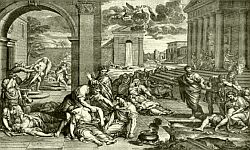
|

1349
 In 1349, a village at the western border of the town was mentioned as "Kytz zu Potstamp." Kytz, or Kiez originates from the Slavonic word chyza, meaning hut or house. It referred to a Slavonic settlement of fishermen near a German town. Today, many towns in the area have a neighborhood called Kiez. Potsdam's Kiez remained an independent settlement until 1722. 
Yet another fishermen settlement, called Burgfischerei (Castle Fishery) just east of Potsdam was first mentioned in 1375.  XXXXXXXXXXXXXXXXXXXXXXXXXXXXXXXX Replica of a Fishermen Kiez |
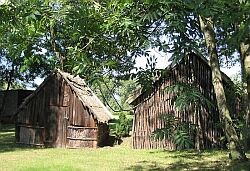
|

1356
 In 1356, the Imperial Diet, headed Emperor Charles IV, enacted a law that would shape the next 400 years of German history. With the Golden Bull of 1356, the Holy Roman Empire became an Elective Monarchy. |
| From now on, seven Kurfürsten or
prince-electors were to choose the future Kings of the Romans,
who would then usually be crowned Holy Roman Emperor of the German Nation by the Pope later. The Brandenburg Margrave became one the seven electors, which significantly elevating the status of the province. However, it had little influence on Potsdam as a town. As the province grew in size, the border moved away from River Havel. Not needed as a fortress anymore, the town slipped into oblivion. It had only around 1,000 inhabitants, a lot less than nearby Hanseatic towns Berlin or Brandenburg.  XX Oldest picture of the seven Prince-electors. (Brandenburg's elector is 2nd from the right.) |
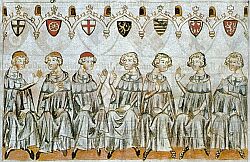
|

1371
 The fifty years of Bavarian rule in Brandenburg were an ongoing story of mismanagement, culminating in 1365 with the installation of Otto V as Margrave and Elector of Brandenburg. It was public custom at the time to give rulers a descriptive name, rather than a number. Rarely has there been a name more fitting than Otto the Lazy. |
Lazy Otto totally neglected his government and spend all his time and money on amusement. In 1371,
Emperor Charles IV had seen enough. He marched into
Brandenburg and forced Otto the Sloth to resign. In 1373, Charles IV installed his own son
Wenceslaus as Margrave of Brandenburg,
starting the age of the House of Luxembourg.
 He also ordered a comprehensive inventory of all real estate in the province. Many towns in Brandenburg and many building within these towns - like Potsdam's oldest church - were first documented in this catalog. XXXXXXXXXXXXThe golden seal of Emperor Charles IV - this is where the "Golden Bull" derived its name from. |
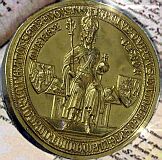
|

A Town put up for Collateral
 The Luxembourgian didn't care much more about Brandenburg than the Bavarians did before. The first Luxembourgian Margrave reigned for only five years and then passed the throne to his younger brother Sigismund, who himself only ten years later, in 1388, handed the province to his cousin Jobst to cover his substantial debt of 565,263 Golden Gulden. Then, in 1410, Jobst too used the Margraviate as collateral for 40,000 Bohemian Gulden owed to William the Rich, Margrave of Meissen.  The Luxembourgians were neither the first nor the last to either sell or pawn the town. The first one to do so was Rudolph I of Saxony after his invasion of Brandenburg in 1323. Between 1323 and 1660, Potsdam was mortgaged out no less than 17 times - more often than any other town in the province.  The constant change of ownership, especially in the 1400s was a great source of income for the rulers, but it also was a permanent source of unrest and is partially to blame for the "Robber-Baron Nuisance" of the late 1300s and early 1400s. |

1412-1414
 In the late 14th and early 15th century, the Brandenburg native family Von Quitzow rose to power and came to own fourteen settlements, including some strong fortresses and castles - one of them (Saarmund) just a couple of miles away from Potsdam. They were so powerful that this period of Brandenburg history is sometimes called the "Age of the von Quitzows". In their native lands they are considered heroes, but the ruling House of Luxembourg regarded them as Robber Barons.  In 1412, German King and Brandenburg Margrave Sigismund of Luxembourg made Frederick, Burgrave of Nuremberg Steward of Brandenburg out of gratitude for services rendered in the power struggle over the German Throne. Within two years, Frederick crushed the Von Quitzow insurgence. His campaign included the world's first documented use of heavy artillery. The canon used was called "Lazy Greta" for it could only fire three shots a day. It was carried by several oxen and had to cool down for hours after every shot. But it was the only weapon strong enough to crush the ten-feet thick walls of the von Quitzow's castle. |
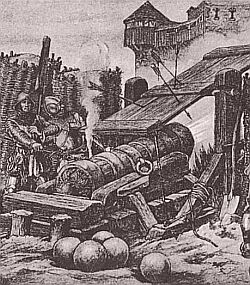  "Lazy Greta" in action |

1415
 In return for his efforts to crush the Robber-Barons, King Sigismund enfeoffed Frederick of Nuremberg with the Brandenburg Margraviate in 1415. As Frederick I, he became the first Brandenburg Prince-elector coming from the House of Hohenzollern, starting a Dynasty that lasted for 20 generations all the way to the end of World War I. In the beginning, the Hohenzollern didn't concern themselves much with their new acquisition and resided far away, in their South-German family estate. To them, the little town of Potsdam was most likely not more than a second-grade property that could be mortgaged out at will.  XXXXXXXXXXXXXXXXXXXXXXXXXXXXX Frederick I receives Brandenburg |
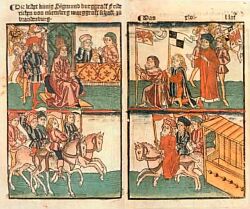
|

| And so, Potsdam, its castle as well as nearby villages kept changing owners depending on the financial situation of the House of Hohenzollern. It wasn't until 1660, that Frederic William, called The Great Elector settled the town's finances once and for all. |

1450
 Written evidence of Potsdam's early years is rare. We couldn't find any population records for the 1400s, but a seal from the year 1450, belonging to the town's judge Andreas Schulte is evidence of some serious development.  In the same year, the office of a mayor has been documented for the first time.
XXXXXXXXXXXXXXXXXXXXXXXXXXXXXX Seal of Judge Andreas Schulte. |

|


1499
 At the end of the 15th century Germans said, that the best place to look for stolen goods was Brandenburg. German poet Theodor Fontane relayed a popular poem of the time:  Dear God, deliver us from Köckeritz and Lüderitz, From Krachten and from Itzenplitz.  The robber-barons were back! And this time, it was not so much an insurgence, but mostly pure economics. Local noblemen wanted their share of growing trade that took place in the land. And the easiest way to a piece of the action was the extortion of "protection fees" for merchants traveling through the country. And if they didn't pay voluntarily, the barons took what they thought was theirs.  |
In 1499, Joachim I became the first Hohenzollern
margrave who
was actually born in Brandenburg. Thus, he made no difference between his claims and those of the old-established families.
 Joachim was only 15 years old, but the robber-barons severely underestimated him. In the first years of his reign, he had as many as 146 troublemakers arrested and many of them executed. In 1516, Joachim founded the Berlin Supreme Court and with that laid the foundation for Brandenburg's praised rule of law. However, the peace wasn't going to last very long.  XXXXXXXXXXXXXXXXXXXXXXXXXX Robber-Barons, attacking a wagon trail |
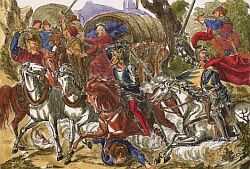
|

1536
 In 1500s, things were finally getting better for Potsdam, or Potstamb as it was called then. In 1524, the first town hall was built and in 1528, Margrave Joachim I started renovating and extending the town's castle. But then, on June 24, 1536, a devastating fire reduced large parts of the town to ashes. Amongst the totally destroyed buildings were the town hall and the registry, resulting in an almost complete loss of all documents regarding the town's written history.  The town recovered surprisingly fast and in 1540 consisted of 120 houses, but then, in 1550, a second fire again destroyed large parts of town. |
 |


| On October 31, 1517 a young Augustinian Monk named Martin Luther nailed his famous 95 Theses to the door of Castle Church in Wittenberg. What was meant to start a dispute amongst religious leaders instead had huge parts of Europe enter a century-long fray. The Brandenburg Margraviate remained Catholic for another twenty years, but soon the new religion had its followers here too. |

1539
 Margrave Joachim I - a pugnacious follower of the Roman Catholic faith - died in 1535. Four years later, his son, Joachim II converted to the new religion. On November 1, 1539, the Margrave attended a Lutheran service at St. Nicholas Church in Spandau and received the Holy Communion.  The date is commonly considered the beginning of the Lutheran Reformation in the Brandenburg Margraviate. XXXXXXXXXXXXXXXXXXXXXXXXXX Joachim II receives the Holy Communion |
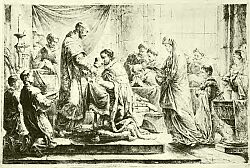
|

1598
 In 1598, Joachim Frederick became Margrave. Like other Margraves before him, he handed the Potsdam estate to his wife. With that, Katharina was the rightful owner of the old Askanian castle, which by now looked rather desolate. In a huge effort, she had the building completely rebuilt within only ten months.  But Katharina died only four years later, and in 1606, the so-called Katharina-Building was impawned and became the property of a local nobleman, who - of all things possible - used it as a barn and sheep pen.  however, the town and theentire country would soon face problems of a way more severe nature.  XXXXXXXXXXXXXXXXXXXXXXXXXXXXXXXX Katharina-Building in 1598 |
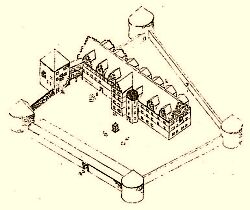
|

1618-1648
 Long before history started numbering world wars, there was a conflict in Central Europe that involved all powers of the western world and - measured by the percentage of population lost - claimed a higher toll on Europe than the two World Wars of the 20th century. In the Thirty Years War, Austria, Spain, France, Holland, Denmark, Sweden and their allies in a Germany that was divided into over 100 principalities, fought over control in Europe and over the only true religion.  Brandenburg was one of the few mediating powers but that didn't keep it from sustaining heavy damage in Europe's battle for power.  XXXXXXXXXXXXXXXXXXXXXXXXXXX Scene from the Thirty Years War |
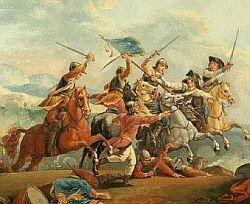
|

Potsdam was absolutely not prepared for that kind of conflict. An inventory of the town's armory listed 20 lances, 19
muskets and 14 halberds - certainly not enough to stop a royal army. In 1626,
Danish soldiers as well as Bohemian troops
under Ernst von Mansfeld raided Potsdam several
times. In 1627, imperial troops under
Wallenstein
took Brandenburg and until 1629, Potsdam had to pay 450 Gold Talers per month for their support. In 1631, Sweden's King
Gustav Adolph took the town with
16,000 soldiers.
 For the locals, it didn't make any difference whether the troops were friend or foe, Catholic or Protestant, German or Swedish. All military units "lived of the land", meaning they looted any town they came through. And so the story continued, and Potsdam was raided by the Saxons in 1633, by the Swedes in 1635 and by marauding troops in 1638 and 1640. Only once, in 1626, local fishermen resisted and chased looting imperial soldiers out of the town.  Aside from that one act of courage, the local population remained lethargic and Potsdam deteriorated so much that there were reports of wolves roaming free in town. In addition to the constant raids, the town was hit by famine in 1630, followed by a plague epidemic in 1631, claiming 308 lives, which by then was one third of the town's population.  At the end of hostilities in 1648, Potsdam was reduced to a hamlet with only 79 inhabited houses. |

1660
 Shortly before the end of the Thirty-Years War, in 1640, the Brandenburg Margraviate got a new ruler: Frederick William, who would later be known as "The Great Elector." Under his leadership, Potsdam rose from the ashes. Starting in 1653, Frederick William settled the debts for Potsdam and its neighbors. In 1660, the Margrave made Potsdam his hunting residence, basically turning it into a second capital next to Berlin. Between 1679 and 1682, he had the City Palace completely renovated and extended and Potsdam finally grew into a real town, exceeding 1,000 inhabitants by 1668.  XXXXXXXXXXXXXXXXXXXXXXXXXXXX City Palace after Reconstruction |
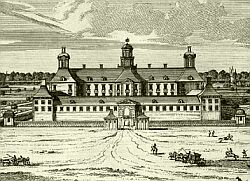
|

1685
 On 29 October 1685, the Great Elector issued the Edict of Potsdam, a declaration of religious tolerance, mainly addressing exiled Huguenots (French protestants) and inviting them into his nation. Not just French, but persecuted peoples from many other nations like Russia, Holland and Bohemia followed the call, making Potsdam a center of European immigration and a safe haven of religious freedom. In the fifty years following the declaration, Potsdam's population grew from 1,500 to 5,500. (In other words, two thirds of the population back then were imigrants). 
XXXXXXXXXXXXXXXXXXXXXXXXXXXXXXXXXXXX Edict of Potsdam |
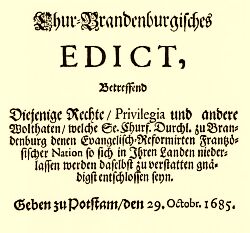
|


1713
 The Great Elector turned Potsdam into a town, made it his second residency (next to Berlin) and started working on the City Palace. But the biggest changes happened under the reign of two kings in the 1700s.  From 1713 until 1740, Frederick William I, popularly known as "the Soldier-King" ruled Prussia. He declared Potsdam the "Heart of the Military Monarchy."  In 1713, only a few months after his inauguration, the first battalion of riflemen marched into town, three more battalions followed shortly after. In 1740, at the end of Frederick William I's reign, 3,500 soldiers were stationed in Potsdam. Most famous military unit were the Potsdam Giants, an elite troop of foot soldiers with a minimum height requirement of 6'2".  XXXXXXXXXXXXXXXXXXXXXXXXXXXXX 7 ft tall James Kirkland, the talles of King Frederick's Giants |

|

1732
 The garrison created its own industry and more and more people were needed to support the army. Between 1713 and 1740, the town's civilian population grew from 1,500 to almost 12,000 and most of them made a living by supplying the military. Two totally new quarters, the first and second city extensions, were built in 1713 and 1733. Also, in 1730, the building of the Dutch Quarters started.  The list of famous buildings erected under Frederick William I is endless and comprises, amongst others, the Garrison Church, the Church of the Holy Spirit, the Military Orphanage and the Great City School.  XXXXXXXXXXX Garrison Church, built in 1732 and destroyed at the end of World War II |
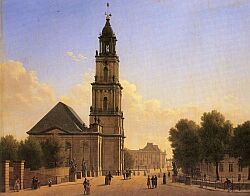
|

1740
 The Soldier King's son, Frederick II ruled Prussia from 1740 to 1768. He fought three wars, but was better known as "The Philosopher on the Throne." His people called him "The Old Fritz" and history knows him as "Frederick the Great," a title he shared with Alexander, Peter and very few others.  |
|
Under the influence of Frederick the Great, the ideas of the
Age of Enlightenment reached Germany.
Under his reign, Potsdam became Prussia's main residency, the City Palace was finished and Potsdam's great castles
Sanssouci and the
New Palace were built. Frederick the Great
employed a number of renowned architects, but his personal influence on the design and decoration of Potsdam's buildings
was so huge that this entire style of European architecture was later called
Frederician Rococo.
|
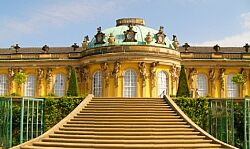
|

1805/06
 In the early 1800, yet another devastating war shattered Europe. Napoleon had invaded Italy, fought the British at sea and in Egypt and was a threat to all his neighbors. In November of 1805, the leaders of Russia and Prussia met in Potsdam's Garrison Church to join forces. Less than a year later, at the Battle of Jena and Auerstedt, their troops were decisively defeated. On October 24, 1806, Napoleon took Potsdam and a day later he marched into Berlin. While in Potsdam, the French Emperor visited the tomb of King Frederick the Great. Here is what American writer John Lawson Stoddard wrote about this moment in history in Volume XVII of his "Lectures." |


1813
 Napoleon occupied Prussia and other German states for seven years until he was defeated at the Battle of Nations in 1813. Half a year earlier, Potsdam was liberated by Prussia's faithful alies: Russian Cosaks.  The fight against Napoleon unified the German people and soon after the Napoleonic War, voices demanding a strong, united Germany could not be overheard anymore.
XXXXXXXXXXXXXXXXXXXXXXXXXXXXXXXXXXXXX Russian Cosaks |

|

1838
 Amidst all the social revolutions, there was also an industrial revolution taking place - dominated by the steam engine. In September, the first Prussian Railroad - between Potsdam and Zehlendorf - was completed and on October 29, the railroad was extended to Berlin - connecting Brandenburg's two most important towns.  XXXXXXXXXXXXXXXXXXXXXXXXXXXXXXXX Potsdam's first Train Station |
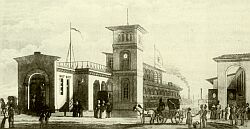
|

1848
 The March Revolution of 1848 lead to the first unified German Parliament and to the first draft of a German constitution. |
During the revolutionary turmoil, Prussian King
Frederick William IV left Berlin and
stayed in relatively calm Potsdam. He was not the only King forced out of his residence. His neighbor,
Frederick Augustus II of Saxony had to flee Saxony's
capital Dresden, asking "Who permitted them to do this?" He was later reinstated with Prussian help.
 The revolution failed and when the German Parliament asked Prussian King Frederick William IV to accept the German Crown, he refused and thus, Germany remained divided into 39 principalities for another generation. XXXXXXXXXXXXXXXXXXXXXXXXXXXXXXXXXXX March Revolution 1848 |
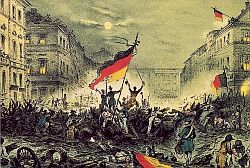
|

1871
 Only half a century after Napoleon's defeat, Prussia and France were yet again at war. A debate over the succession of the vacant Spanish Throne (really) lead France to declare war on Prussia on July 19, 1870. But this time, the table had turned. A series of swift Prussian and German victories in eastern France culminated in the Battle of Sedan, at which Napoleon III was captured with his whole army on 2 September.  The German Unification, attempted from the bottom up during the revolution of 1848, was now conducted from the top down, when Prussian King Wilhelm I accepted the German crown and became mperor of the German Empire. The coronation took place on French soil in the palace of Versailles on January 18, 1871. Potsdam became the Emperor's Residency.  XXXXXXXXXXXXXXX X Coronation of German Emperor Wilhelm I in Versailles, France |
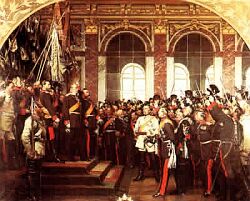
|


1911
 Between wars, Potsdam took care of its image as a center of art and culture. The world's first large Film Studio (a couple of months older than Hollywood), the Film Studio Babelsberg opened in a Potsdam suburb in November 1911. A countless number of films, from Friz Lang's Metropolis over The Blue Angel with Marlene Dietrich to Valkyrie with Tom Cruise have been produced here.  Today, the Babelsberg Studios are Europe's largest film studio and about 80% of all German films are produced with Potsdam's support.  XXXXXXXXX X German Actor Hans Albers in one of his most famous films, "Münchhausen" |
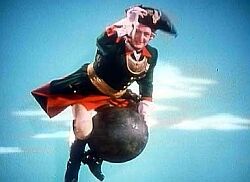
|

1914
 But, yet again, the next war was not far away. After the assassination of Austrian Archduke Franz Ferdinand in June 1914, Germany's ally Austria declared war on Serbia and Russia. Germany first hesitated, but on July 30, 1914, German Emperor Wilhelm II arrived in Potsdam's New Palace and signed Germany's Declaration of War to Russia. In the following four years, the "Great War" would cost the lives of about 17 million people from over 30 nations. for Germany, the war ended with a Revolution in November 1918, driving the last Emperor into exile and ending 502 years of Hohenzollern Dynasty in Potsdam.  XXXXXXXXXXXXXXXXXXXXXXXXX German Emperor Wilhelm II and his generals |
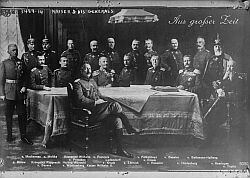
|

1918
 The Revolution of 1918 was the end of Monarchy in Germany and the end of the Hohenzollern dynasty in Brandenburg, but not yet the end of Prussia. Germany became a republic and the former kingdoms within the German Empire became "Freistaaten" - a German word for republic. In a time of turmoil, the Prussian Republic was a haven of stability and democracy, governed for most of the time by prime minister Otto Braun.  All of that would change with the rise of the Nazis in the 1930s.  XXXXXXXXXXXXXXXXXXXXXXXXXXXXXXX November Revolution of 1918 |
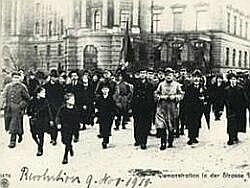
|

July 20, 1932
 The economically and politically unstable 1920s paved the way for the rise of the Nazis. In the early 1930s, the Prussian government under Otto Braun, with authority over the powerful Prussian police force, was one of the last major republican forces against Reichskanzler Franz von Papen who believed that Hitler and his Nazi Party could be controlled once he was in the government and who persuaded President Hindenburg to put aside his scruples and approve Hitler as Chancellor. One of the major steps of Hitler's rise to power was the Prussian Coup. On July 20, 1932, Hindenburg issued an emergency decree which dismissed the cabinet of the Prussian Republic and declared Papen Commissioner of Prussia. Only six month later, on January 30, 1933, Hitler became Chancellor of Germany.  XXXXXXXXXXXXXXXXXXXXXXXXXXX Chancellor Papen at the 1932 elections |
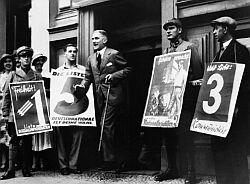
|

March 21, 1933
 Hitler and his party did everything to wipe out the opposition. Sometimes they used brute force, and sometimes just pure demagogy. Hitler was seeking a two-third majority in the German parliament. To get the votes of German conservatives, the Nazis orchestrated a symbolic handshake between Chancellor Hitler and President Hindenburg in Potsdam's Garrison Church. Two days later, the German parliament passed the Enabling Act, making Hitler absolute ruler.  We couldn't bring ourselves to post a picture of those two @#&*s, but you can check it out at the German wikipedia article about the day that would later be known as the Day of Potsdam. Instead, our 1945 section will show a picture taken after an event, that was later called the Night of Potsdam. |

|
We all know what happened next. As Ernst Thälmann, one of the Nazi's
most prominent prisoners had foreseen: "A vote for Hindenburg is a vote for Hitler; a vote for Hitler is a vote for war." The following twelve
years cost the lives of 73 million people worldwide, brought a
Holocaust that will forever remain on German conscience and left Germany in
ruins - and it can all be traced back to this fatal handshake.
April 15, 1945
|
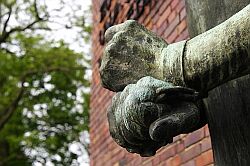
|

August 2, 1945
 Less than a month after the "Night of Potsdam", Germany surrendered, ending World War II in Europe. In July 1945, the leaders of the winning nations, British Prime Minister Winston Churchill, Soviet General Secretary Joseph Stalin and US President Harry S. Truman met to discuss how to administer the defeated country, and how to establish a post-war order. They did not meet in the German capital but in Potsdam, which was commonly recognized as the cradle of German militarism. What started in 1933 with a handshake between Hitler and Hindenburg, ended in the same town in 1945 with a handshake between the allied leaders. At the Potsdam Conference, the allies divided Germany into four zones and Potsdam ended up in the Soviet zone. But the Western allies (France, Great Britain and the USA) kept a symbolic presence, called Military Mission, in town. Throughout the Cold War years, Potsdam always had a somewhat special status, being the only town in the East with Western military presence (an a giant US flag flying in town).  XXXXXXXXXXXXXXXXXX Another historic handshake: Churchill, Truman and Stalin |
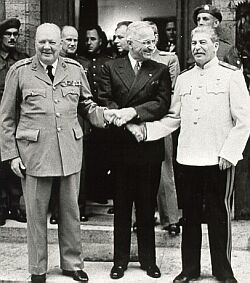
|

August 6 & 9, 1945
 World War II ended with one last cruelty, Atomic Bombing of Hiroshima und Nagasaki.  The orders were personally confirmed by President Truman, who, at this time, lived in a villa at Potsdam's Lake Griebnitzsee. Today, the square adjacent to the villa is called Hiroshima-Square. Left: Truman's villa during the Potsdam Conference. Right: Mushroom cloud over Nagasaki. |
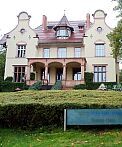
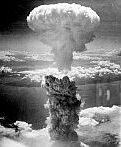
|

August 13, 1961
 The Potsdam Agreement called for a democratic, united Germany under temporary administration of the four allies, but history had other plans. The former allies were soon entrenched in a forty-year long Cold War. In 1949, two separate German States were founded an in the 1950s, an Iron Curtain came down across Europe.  On a Sunday in August 1961, this curtain received its boldest manifestation with the building of the Berlin Wall. In first place, the Wall divided Berlin, but it also cut off Potsdam from its connection to the German capital. There was only one check point between Potsdam and West Berlin, and it was off limits to Germans from both sides.  That point was Glienicke Bridge, better known as the Bridge of Spies for it was here that American and Russian secret services exchanged spies caught on the other side.  Top: Glienicke Bridge seen from the Havel River. Bottom: Russian Check Point at the bridge. |
 |

| Potsdam now was no longer the capital of Brandenburg or Prussia. The Soviet administration abolished the traditional structure of German States and divided the East German territory into 14 districts. |

1978
 Between 1889 and 1935, there were three merchant ships named "Potsdam" - the last one went as reparation payment to Great Brittan in 1946. Starting in 1957, the fledging East German merchant fleet commissioned ships named after the 14 East German administrative districts. Over the years, every district had a ship in its name - with one exception: East German officials thought it would be too offensive to the world to name a ship after "The cradle of German Militarism."  It wasn't until June 23, 1978, that the name Potsdam was once again carried across the world's oceans. Most likely, this would have never happened without Potsdam's major Brunhilde Hanke, who never received proper credit for decades of work to restore Potsdam's good name in the world.  XXXXXXXXXXXXXXXXXXXXXXXXXXXXXXXXXXX M/V Potsdam in 1978. |
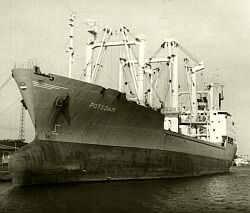
|


November 9, 1989
 Oscar Wilde once said, "Life is a bad hour with a few good moments." November 9, 1989 was such a good - and totally unexpected - moment. At 6 pm, East German government speaker Günter Schabowski announced that all rules for traveling abroad were going to be lifted. When Italian journalist Riccardo Ehrman asked for a time frame, the somewhat surprised speaker stuttered, "... as far as I know ... this shuld be ... immediately."  Within hours, tens of thousands of people gathered along the Wall. All the big political and military leaders were hiding, leaving lieutenant colonel Harald Jäger in charge of the border control. At 11.30, in direct violation of his orders, the courageous officer ordered to "Open the Floodgates." The rest is history.  XXXXXXXXXXXXXXXXXXXXXXXXX Steffen and Volker at the remains of the Wall |

|

August 17, 1991
 As a philosopher I have lived and as a philosopher I want to be buried - without pomp and without ceremony... Burry me quietly at the terraces of Sanssouci; to the right of the castle.  Potsdam owes a lot to King Frederick the Great, and town repaid him by neglecting his final wish for 205 years!  XXXXXXXXXXXXXXXXXXXXX The simple grave of the "Philosopher on the Thron" |
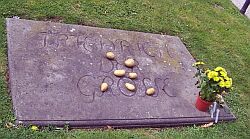
|
 First, the King was -a against his wishes - buried next to his father in Potsdam's Garrison Church. At the end of World War II, his resting place changed three times intil he fond a temporary last home at the Hohenzollern Castle in Baden-Württemberg. It wasn't until the 205th anniversary in 1991, that Prussia's greatest King got his final wish granted and was entombed in the crypt next to Sanssouci Castle.  Together with the tomb, the spirit of "Old Fritz" had returned to Potsdam. His final burial was just the beginning of rebuilding Potsdam as the city he once had in mind. A lot of buildings have been rebuilt since 1991 and with the restauration of the Fortuna Portal, the Pleasure Garden, and the Pfingstberg Belvedere, the town has already regained much of its old charme. Rebuilding the City Palace and the Garrison Church will take a little bit more time, but by 2012, Potsdam will have rissen to old glory. |

April 9, 1995
 Ever since King Frederick the Great brought the age of Enlightenment to Potsdam, science had its place here. Since 1847, Potsdam has been Germany's center for meteorology, geology and other earth-related sciences.  Since 1995, this science is not earthbound anymore. A Russian Progress transporter delivered a satellite, built in Potsdam to the Mir Space Station. It was jettisoned into orbit on April 19th, 1995, 19:12 UT. Another satellite followed in 2000 and today, Potsdam's Research Center for Geosciences takes a vital part in several satellite projects, reaching from the remote detection of minerals to Tsunami warning centers in the Indian Ocean.  XXXXXXXXXXXXXXXXXXXXXXXXXXXXXX GFZ-1, Potsdam's first satellite |
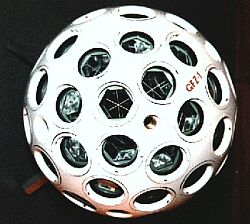
|

|
A thousand years after Slavonic hunters discovered a muddy river passage, Potsdam reached for the stars! |



Back to Potsdam Page |

Back to Home Towns |

Back to Germany Page |
 Back to English Main Page |
 Back to Start Page |